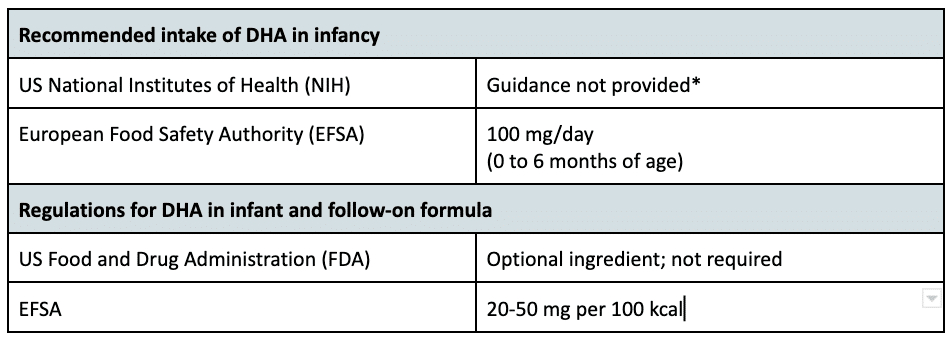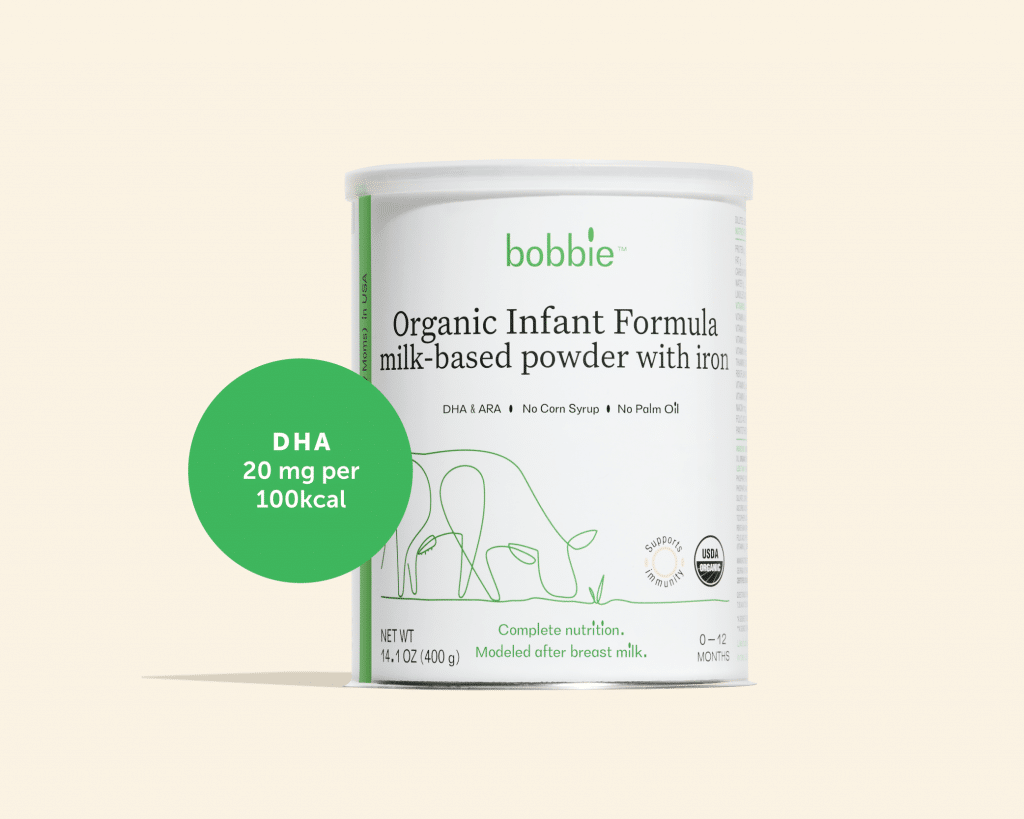We are proud to say that these posts are not sponsored. Our editorial team of Bobbie moms and writers personally select each featured product. If you buy something through our links, we may earn an affiliate commission, at no cost to you.
Welcome to our Expert Insight Ingredient Series! In this series of articles, we’ll be highlighting ingredients in infant formula that play key roles in early health and development. We’re kicking this off by exploring DHA. You can also check out our DHA Ingredient Guide for more details!
If you’re a parent, you’ve likely heard of DHA — short for docosahexaenoic acid. This omega-3 fatty acid is a hot topic in conversations about pregnancy, infant health and early childhood development. It’s commonly found in prenatal vitamins and recommended for breastfeeding moms. Plus, it’s included in infant formulas and even added to milk and other beverages for toddlers and older children.
In this installment of our ingredient series, we’ll explore the science behind DHA and why it’s such an essential nutrient for early-life nutrition.
Curious to learn more? Check out our DHA Ingredient Guide for all the details!
What Is DHA and Why Is It Important for My Baby?
DHA, along with other long-chain polyunsaturated fatty acids (LCPUFAs) like arachidonic acid (ARA), has rightfully gained attention in the nutrition world for its role in early development. This omega-3 fatty acid supports important processes in the body and serves as a vital building block for your little one’s tissues and membranes.
During infancy, DHA serves as a crucial nutrient and plays a central role in:
Fueling Your Baby’s Brain Development
The brain absorbs significant amounts of DHA both during pregnancy (mainly during the third trimester) and after birth. In fact, the first two years of life are when brain DHA uptake is at its peak — a time when the brain is growing at lightning speed. According to FHI 360 research, the brain grows faster before your child’s second birthday than at any other time in life. This early stage is a crucial window where optimal infant nutrition is essential for healthy development.
Protecting and Developing Your Little One’s Vision
DHA is the main fatty acid in the retina of the eye, which supports our ability to see. How? Essentially, the retina receives and organizes visual information, then sends signals to the brain that allow us to process what we’re looking at. DHA supplementation may also help protect this important tissue in our eyes.
Supporting Immune Health in Infancy
There’s some evidence suggesting that DHA and ARA may help support the immune system, especially during early infancy when it’s developing quickly. In fact, research shows that babies fed formula with ARA and DHA supplementation had immune function markers similar to those of breastfed infants.
Explore the Health Benefits of DHA
DHA content has been extensively studied over the past few decades to understand how it affects infant development. And this research from preclinical and clinical trials on DHA and ARA has contributed to their addition in baby formulas — an important breakthrough in infant feeding.
Here’s a closer look at a few key findings, including how DHA:
1. Boosts Cognitive Development
DHA and ARA supplementation in infancy has been shown to positively affect cognitive development — even after the formula period. In one study, infants given formula with ARA and DHA supplements until four months of age processed information more quickly at six years old than those who didn’t receive supplementation.
2. Enhances Mental Flexibility
A systematic review of mental adaptability and flexibility in three-year-olds also suggests that DHA and ARA influence cognitive development. Healthy children who received the recommended dose of DHA and ARA supplementation demonstrated higher cognitive function than those taking less than optimal doses.
3. Improves Visual Acuity
Further clinical studies have shown that ARA and DHA supplementation boosted visual acuity during an infant’s first year of life. Interestingly, these results were based on a specific amount of DHA — 0.32% of total fat — similar to what’s found in breast milk. This highlights the importance of DHA content in baby formula to mimic these nutritional benefits.
4. Supports Lifelong Health Benefits
Long-term follow-up of infants who received ARA and DHA supplements found that by the age of four, their vision was on par with that of breastfed infants — the gold standard in infant feeding.
DHA Benefits Beyond Infancy
The benefits of DHA extend beyond infancy — research shows it offers positive effects for older healthy children and adults, too. When combined with another omega-3, eicosapentaenoic acid (EPA), DHA can potentially support heart health. It may also help reduce inflammation, promote eye health in adults and assist with behavior and attention in people with ADHD.
ARA Matters for Infant Development, Too!
As infant nutrition research on LCPUFAs continues, scientists are discovering that both DHA and ARA are crucial to include in baby formula. What’s more, the ratio of DHA to ARA matters. Studies show a positive developmental outcome when ARA is at least equal to, or up to twice the amount of, DHA. That means ratios with higher or lower amounts of ARA may not provide the same benefits.
What Are the Recommended Intakes of DHA in the U.S. and Europe?
Alpha-linolenic acid (ALA) is the “parent” fatty acid of the DHA group. While our bodies can convert ALA into DHA through a series of steps, this process isn’t very efficient. At the same time, some people — based on their genetics — convert ALA to DHA at much lower rates. That’s why it’s important to get DHA directly from our diets. For infants, this means relying on breast milk or infant formula to provide the DHA content they need.
However, it’s important to note the clear differences in recommended DHA intake during infancy between the U.S. and Europe. This includes specific regulations around adding DHA to infant formula in the U.S.
Explore these recommendations in more detail below:

*the US NIH recommends 0 to 12 month olds consume 500 mg per day of omega-3 fatty acids but does not provide guidance for DHA intake specifically.
Alpha-linoleic acid (ALA) is the “parent” fatty acid to DHA. Our bodies, through a series of complex steps, can convert ALA into DHA. However, in general, we don’t do this very efficiently. Further, some people – depending on genetics – have very low rates of converting ALA to DHA at all. For this reason, it’s important that DHA is consumed directly in the diet. Therefore, infants rely on breast milk or infant formula for their DHA.
DHA 101: Your Top Questions Answered
Discover answers to some of the most frequently asked questions about DHA and its role in infant development:
Is DHA found in breast milk or only in formula?
Absolutely! DHA is naturally found in human milk, although the amount may vary depending on the mother’s diet. If you’re breastfeeding, your baby is likely getting the DHA they need. For formula-fed babies, DHA supplements are added to formulas, so they receive the same benefits as breast-fed little ones.
How can I tell if my baby is getting enough DHA?
If you’re breastfeeding and eating omega-3-rich foods, your baby is likely getting enough DHA. For parents using formula, DHA-enriched options will provide the right amount for healthy infant development. If you’re ever unsure, don’t hesitate to reach out to your pediatrician for personalized guidance and peace of mind!
Should I give my baby a DHA supplement?
While you can give your little one a DHA supplement, it’s best to start with breast milk or DHA-enriched baby formula. These sources provide the right amount of this fatty acid, along with other essential nutrients to support overall development — making them the most effective choice unless your pediatrician suggests otherwise.
Are there natural food sources of DHA I can consider?
Yes! Once your baby starts solids, you can introduce DHA-rich foods like fatty fish, including salmon, sardines or mackerel. You might also offer fortified eggs and algae-based products. These foods are excellent options for supporting your baby’s visual acuity, cognitive function and overall growth. Just be sure to introduce new foods gradually and consult your pediatrician for guidance on appropriate portions and any potential allergies.
DHA in Bobbie Baby Formula
When it comes to DHA and infants, Bobbie Organic Infant Formula offers 20 mg of DHA per 100 kcal. This is designed to meet the EU requirement of 20-50 mg of DHA per 100 kcal in infant formulas. And while fish oil is commonly used for DHA, fish actually get their DHA intake from plants. That’s why Bobbie takes a more direct approach, using Schizochytrium — a single-cell algae that’s naturally high in DHA. Plus, Bobbie infant formula includes ARA, which is important because many of DHA’s health benefits have been observed in studies where ARA was also included.
For more insights on DHA’s role in early infant nutrition, check out the Bobbie DHA Ingredient Guide or learn more about DHA in formula here.
DHA in Bobbie Baby Formula

Bobbie organic infant formula provides 20 mg of DHA per 100 kcal, meeting the EU mandate that infant formula contains 20-50 mg DHA per 100 kcal. While fish oil is commonly used as a source of DHA, the reality is that fish get their DHA by eating plants…so Bobbie uses a plant source directly – a single-cell algae called Schizochytrium which is high in DHA.
Bobbie infant formula also provides ARA, an important distinction since many of the health benefits of DHA have been observed in studies where ARA was also provided.
For an overview of the importance of DHA in early nutrition, check out the Bobbie DHA Ingredient Guide. You can also read more about DHA in infant formula here.
Sources:
- Docosahexaenoic Acid and Arachidonic Acid Nutrition in Early Development
- Evidence for the essentiality of arachidonic and docosahexaenoic acid in the postnatal maternal and infant diet for the development of the infant’s immune system early in life
- Role of n-3 long-chain polyunsaturated fatty acids in human nutrition and health: review of recent studies and recommendations
- Building Brains – 1,000 Days
- Retina Function, Anatomy & Anatomy | Body Maps
- Evidence for the essentiality of arachidonic and docosahexaenoic acid in the postnatal maternal and infant diet for the development of the infant’s immune system early in life
- Effect of providing a formula supplemented with long-chain polyunsaturated fatty acids on immunity in full-term neonates
- Effects of long-chain PUFA supplementation in infant formula on cognitive function in later childhood
- Docosahexaenoic acid (DHA) and arachidonic acid (ARA) balance in developmental outcomes
- The DIAMOND (DHA Intake And Measurement Of Neural Development) Study: a double-masked, randomized controlled clinical trial of the maturation of infant visual acuity as a function of the dietary level of docosahexaenoic acid
- Visual acuity and cognitive outcomes at 4 years of age in a double-blind, randomized trial of long-chain polyunsaturated fatty acid-supplemented infant formula
- The Importance of the Right Fatty Acids in Infant Nutrition

